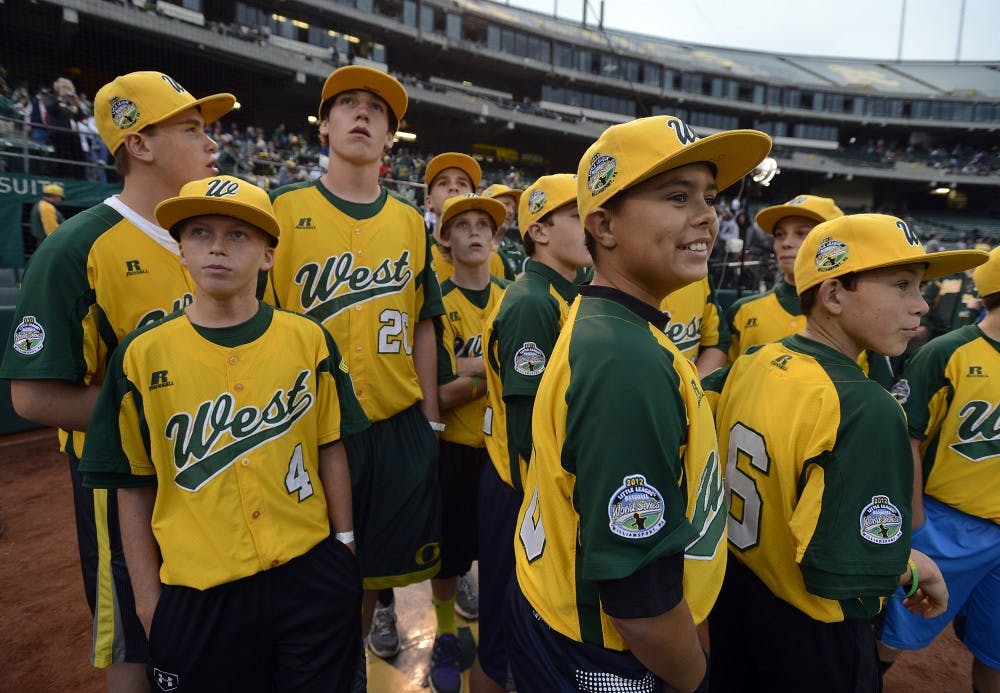On Saturday afternoon, Mekhi Garrard left a fastball that rode just above the belt of the batter, Cole Wagner, which he lofted about five feet beyond the center field fence of Howard J. Lamade Stadium in Williamsport, Pennsylvania, for his second grand slam of the day during an elimination game of the Little League World Series.
Garrard, a pitcher representing the Midwest region for the team from Webb City, Missouri, had a priceless reaction that was swiftly captured by the ESPN cameras. With his back to home plate, he gazed with wide eyes toward the outfield wall as his mouth hung open. It was a snapshot of genuine emotion from a child playing and enjoying a game invented for children.
What’s wrong with this picture? Nothing, except for a few inconvenient details. His team lost 18-0 to the Mid-Atlantic team from Lewisberry, Pennsylvania. Also, Garrard, at 5-foot-1 and 86 pounds, was facing a 5-foot-11, 189 pound first baseman in Wagner, who may have also been several years older, given that players can be as young as nine and as old as 13 if they are born on or after May 1.
ESPN, in its expanded coverage of the Little League World Series in recent years, has given the iconic youth baseball event unprecedented international exposure. ESPN ran with the headline “Pitcher reminds us what Little League is all about,” which allowed the story to surge briefly atop the peak of trending social media topics.
Thanks, Mekhi Garrard, for reminding us what Little League is all about—kids having fun http://t.co/s6JRdqhmyV https://t.co/ZJoRzfW1U5
— Sports Illustrated (@SInow) August 22, 2015
From catcher Kaden Peifer’s obnoxious leg kick on his three-run home run swing in the first inning, to the overzealous call from the network’s play-by-play announcer, artificial drama supplied by cinematic camera work and the excessive celebration that followed from teammates for Wagner in a game that had already gotten well out of hand, the sequence formed the quintessential youth sports highlight.
If in fact the Little League World Series is a reflection of the best youth baseball in the U.S. and the world, then why were half of the U.S. regional championships required to invoke the mercy rule? Why was the average margin of defeat (for those eight games alone) 7.5 runs? For the sake of comparison, six of eight international opening-round games were decided by two runs or less and just one (Asia-Pacific vs. Canada, a 16-4 final) ended via the mercy rule.
The lack of competitive balance at the highest level of American youth baseball is alarming. It should not be difficult to achieve. The goal of Little League, as explained in the following excerpt from the organization’s mission statement, should be to eliminate such disproportionate results.
“Through proper guidance and exemplary leadership, the Little League program assists youth in developing the qualities of citizenship, discipline, teamwork and physical well-being," according to Little League International. "By espousing the virtues of character, courage and loyalty, the Little League Baseball® and Softball program is designed to develop superior citizens rather than stellar athletes.”
It’s impossible to regulate baseball to the extent that there will never be a blowout without compromising the integrity of the sport.
Lopsided games are not fun for either side, and essentially serve no purpose, especially to an opponent that clearly didn’t belong in the same tier with the other older, bigger, stronger and more skilled team.
The only lesson to learn in such a scenario is to win graciously, and accept defeat in the same manner.
Using aluminum bats that turn upper-cuts and half-swings into home runs (strategically marketed to appeal to impressionable young players) and having doubles become inside-the-park home runs because of misplays by inexperienced outfielders doesn’t exactly inspire much confidence in the quality of the baseball being played in Williamsport.
The coaching needs to improve significantly. No one is expecting every Little Leaguer to be Mike Trout, but perhaps the volunteers in charge of these teams could point to the Los Angeles Angels superstar as a figure to emulate his plate discipline.
You won’t see Trout, or any other successful hitter, lunging at balls outside the zone and throwing out his hands at the last second praying to make contact.
There should be some baseline standards set for what we perceive to be the best 9-13 year olds in the world. Or they should replace the other players with better ones who might be held back by socioeconomic or political barriers, both in inner cities and farm towns.
Adults, however, seem to be at the forefront of what’s wrong with most of youth sports.
Jackie Robinson West, despite being caught red-handed, embarrassingly tried to file a lawsuit against Little League when its run to the title game was washed away by a redistricting scandal.
Just days ago, a Washington Little League softball team was accused of throwing games to secure a better matchup for the tournament.
The final line of the Little League mission statement tugs at the heartstrings, and evokes a rush of emotion and fond memories.
“The outcome of a game will never outlive the pride of belonging, the experience of playing, the friends and the fun. The essence of Little League is the people, their communities, and the everlasting bond between them.”
There’s nothing fun about losing 18-0. Garrard made the best of his situation, but he deserved better.
Even with just the slightest emphasis on improved fundamentals, and a desire to structure tournaments in an effort to pair teams appropriately based on levels of competition, Little League baseball could go a long way in ensuring that it doesn’t embarrass itself yet again.
Related Links:
Thank you, Jackie Robinson West
Though adorable, Little League World Series hard to stomach
Reach the sports editor at smodrich@asu.edu or follow @StefanJModrich on Twitter.
Like State Press Sports on Facebook and follow @statepressport on Twitter.




